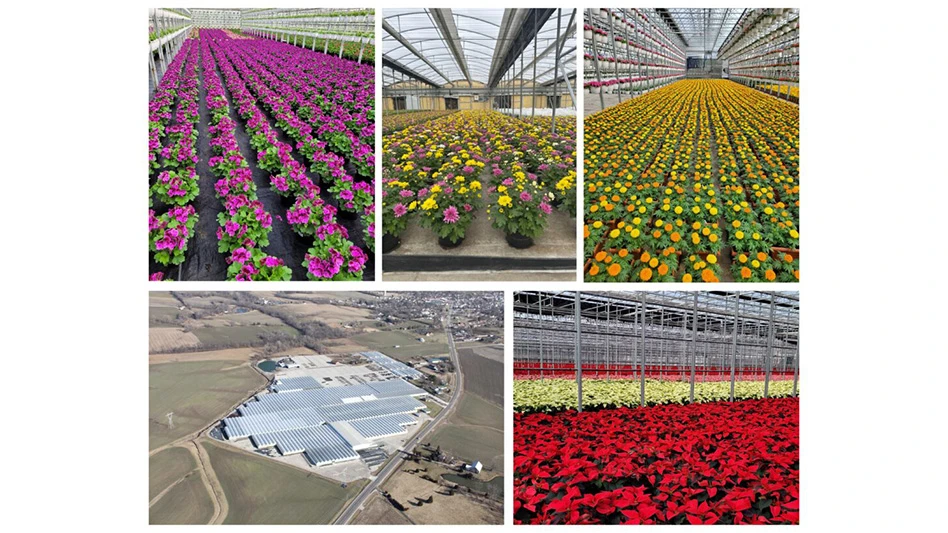Mechanical thermostats are rapidly becoming obsolete. When you consider that replacing a thermostat with a 4-6°F differential between on and off with an electronic controller having a 2°F differential, the savings in energy are significant. This results in lower heat loss from the greenhouse surface, as the heater shuts off much sooner.
For exampIe, if we assume a 30’ x 100’ double covered greenhouse in a northern climate (Hartford, Conn.) heated to a night temperature of 60°F during the winter, replacing the mechanical thermostat having a differential of 6°F with a controller having a 2°F differential will result in a savings of about 500 gallons of fuel oil, 675 gallons of propane or 600 ccf of natural gas. Instead of heating the greenhouse air to 66°F before the heater shuts off, the controller will shut the heater off at 62°F. For each degree that the temperature in the greenhouse can be lowered, there is an approximate 3 percent savings in fuel. At today’s energy prices, the payback for installing the controller is less than two years.
A programmable controller is a control device that has logic potential but is not powerful enough to be called a computer. The simplest ones replace several thermostats and usually have 5 to 6 stages of control (two heat stages and 3 or 4 cooling stages, plus a setpoint).

Step controllers use a solid-state integrated circuit to monitor environmental data in the greenhouse and create output signals that activate equipment based on a set of internal programmed instructions. The microprocessor is a simple, low-cost device that is reliable, accurate and works well in a greenhouse environment. Cost for basic step controllers usually runs from $600 to $1500, depending on the number of steps and relays or contactors that are needed to control the equipment.
Controller advantages include:
The heating and cooling functions of the greenhouse are divided into stages and the controller steps between stages as conditions in the greenhouse change. Multiple pieces of equipment can be assigned to each stage, such as two heaters, HAF fans and an energy screen at stage 2. The sequence of equipment operation and the temperature at each stage is programmed by the grower.
All components are located in one waterproof enclosure, reducing moisture, dust and maintenance.
Installation time is reduced as relays, switches and controls are prewired.
The sensor is remote and can be located among the plants while the control box is out of the plant zone.
Energy use is reduced due to more accurate sensing and control.

Controllers operate with a setpoint — the air temperature that you would like in the greenhouse. If the temperature falls below the setpoint, the heating system will be activated. If the temperature exceeds the setpoint, the vents will open or the fans will activate, providing cool air. With multiple cooling stages, a different setting on the vents or additional fans will start. A final stage could include the activation of an evaporative cooling system. An override is provided at each stage for manual operation.
The following features or functions may be standard or optional depending on the manufacturer and model: LED screen, battery backup, alarm activation, ramping, temperature sensitivity, temperature difference between stages, day-night temperature setting, programmable night cooling lockout, aspirated sensor box and tracking.
Advanced controllers offer many of the above features plus additional stages of control, input from a weather station and the ability to control multiple zones.
The above describes the typical temperature controller. There have been many specialized controllers developed during the past few years that control other greenhouse equipment: ventilation controllers, irrigation and misting controllers, energy/shade screen system controllers, demand shedding controllers and boiler controllers.
USDA NRCS and some state and utility energy programs have grants that pay up to 75 percent of the cost of more efficient control systems. A good website to view for grant programs is dsireusa.org
Controllers are the next level of control above thermostats and time clocks. They have proven to provide better environment control, while at the same time saving energy.

Explore the July 2017 Issue
Check out more from this issue and find your next story to read.
Latest from Greenhouse Management
- Terra Nova Nurseries introduces rust-free and disease-resistant heucherella
- John T. Nickel, founder of Greenleaf Nursery Co., passes away at 89
- Three tours offered at 2025 Farwest Show
- Garden Media Group announces sixth annual Women in Horticulture Week
- Star Roses and Plants announces National Knock Out Rose Day
- The Growth Industry Episode 4: How federal budget cuts are affecting horticulture nonprofits
- The thrips battle plan
- Pennsylvania Horticultural Society shares top gardening trends from 2025 Philadelphia Flower Show





